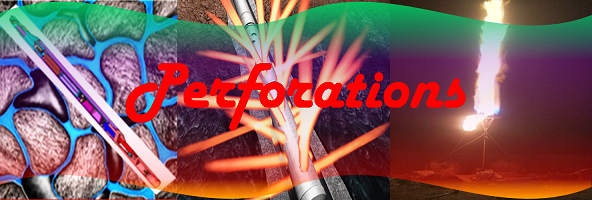Site Navigation
Oilfield expertise at your desktop
Oilfield Perforation methods
Perforations serve as a basic communication channel between the formation and the cased/cemented wellbore. Perforations may be carried out in two conditions:
- Overbalanced Perforation
- Underbalanced Perforation
Perforating operation can be broadly classified as:
- Conventional
- TCP and TTP
Perforating operations with explosives mostly use shaped RDX charges for firing. A perforating assembly requires the following materials:
- Shape Charge (secondary explosives)
- Prima Cord (RDX-40,80,60 used)
- Detonator (G-21,A-105, RED)
- Gun body
- Center & body wire
In shape charges RDX is used. RDX-80 is the conventional material for a normal perforation job. Here 80 indicate the grain size/ft. of RDX present. RDX-40 is used for Tubing puncture jobs.
Detonator does the main job of firing the explosive in the prima cord. Detonators conventionally used are G-21 and A-105. They have an Electrically Isolated fuse which triggers a reaction upon electricity supply. RED (Rig Environment Detonator) is used to perforate in those areas where high tension power lines are passing nearby the drilling rig.
Mainly two types of guns are used in perforation job to fire the explosives;
- HSC guns (underbalanced condition)
- TAGs (overbalanced condition)
Hollow Steel Carrier (HSC) Guns are reusable and are available with various firing capacities and diameters. They come mainly in three lengths, 4 feet, 7 feet and 11 feet each with a capacity of 12 shots per meter (SPM) approximately with each shot being at 120° from the adjacent shot. Throw Away Gun’s (TAG) is not reusable and are gaining more popularity over the HSC Guns. The chance of failure is considered to be the least in this type of guns. This type of guns also comes in many lengths with a firing capacity of 18 Shots per meter (SPM) approximately with each shot being at 60° from the adjacent shot.
There are three methods for the conveyance of the perforating guns;
- Through Casing (Conventional)
- Through Tubing (TTP) and
- Tubing Conveyed (TCP)s
In Through Tubing Perforations (TTP), tubing‘s are lowered within the well bottom to the required depth and positioned. Subsequently a perforating system by wire line is lowered and perforated against the zone of interest. To carry out this job we need well head pressure control system. Here the guns are usually run with a de-centralizer. Gun length is limited and usually smaller guns are preferred.
In Tubing Conveyed Perforations the system consists of a casing perforating gun run into the well at the bottom of a string of production tubing or drill pipe. The perforating gun can be assembled for any required length and shot density. Depth control is obtained by running a GR and CCL tool. After positioning and setting the packer, the guns are fired. With under balanced conditions, well flow is usually initiated upon firing.
Above article is taken from from Masters report titled ” Logging Techniques Interpretation and advances using LWD in horizontal drilling: a case study from Cambay Basin”.
